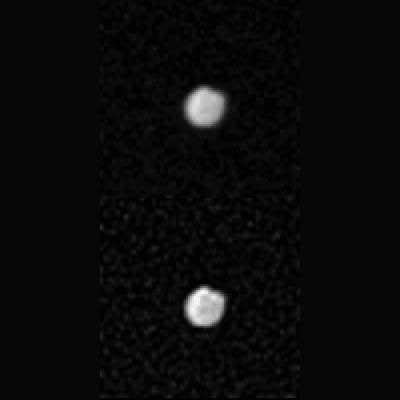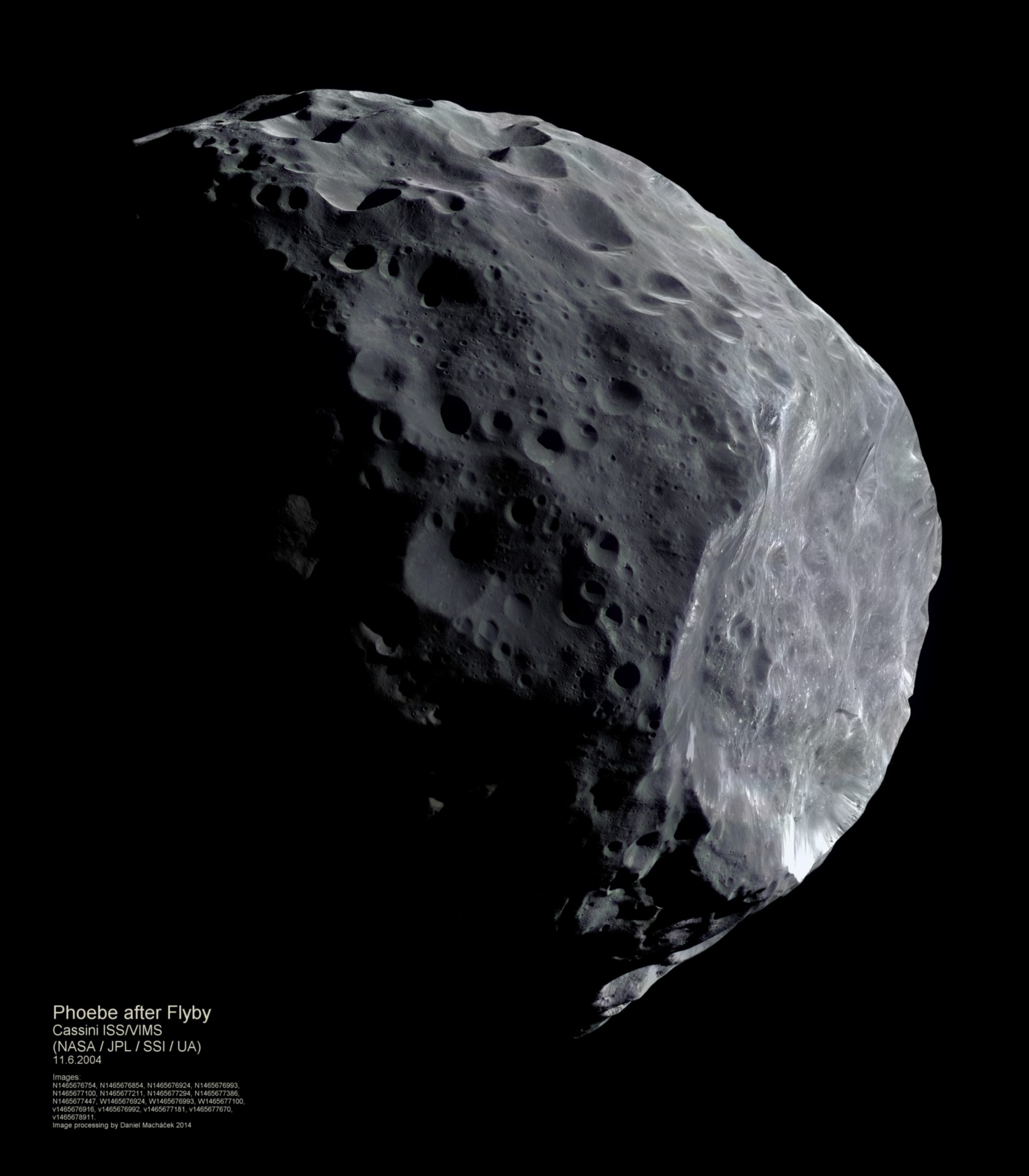Daniel Macháček • Feb 13, 2014
The Two Faces of Phoebe
This post originally appeared in Czech on Daniel Macháček's blog My Favourite Universe and has been translated and reposted here with his approval.
It has been almost ten years since the international spacecraft Cassini (NASA/ESA/ASI) arrived at the Saturn system. Since then, every day brings new knowledge about the gas giant and its surroundings. Cassini went into orbit around Saturn in July 2004, but today I will focus on events that occurred even before that.
The flight plan included a close flyby of one of Saturn's outer irregular moons. No one else had ever accomplished this before, despite the fact that dozens of such moons orbit not only Saturn, but also Jupiter. So a couple of weeks before the arrival of the probe to the target planet, on June 11, 2004, Cassini flew within 2,068 kilometers of the moon Phoebe.

Phoebe was discovered more than 100 years ago, and before Cassini we had photographs from Voyager 2, which flew by it 1981. At that time, however, we were not so lucky, because the flyby distance was about 2.2 million kilometers. Even with a powerful camera with telephoto lens and a moon as large as Phoebe, Voyager could barely distinguish features on a disk with a diameter of about 10 pixels.
With these images, scientists were able to deduce the rotation rate, determine the position of the poles, assemble the first rough map of the surface, and finally measure the diameter of Phoebe at about 220 kilometers.
The real breakthrough in the understanding of Phoebe was thanks to Cassini. Long before the spacecraft reached Phoebe it was known that Cassini would have only one attempt at the encounter, because Phoebe is too far from Saturn, outside of the normal "reach" of Cassini. Observations were thus performed by the vast majority of instruments on the probe. The situation was made more complicated by the fact that while Cassini was still in the design stage, a scan platform for the instruments was descoped as a cost-saving measure. Since instruments often have different view directions, it meant that the entire ship has to be rotated frequently during close encounters.

The Phoebe flyby generated a lot of anticipation among both the scientific and lay community, because although Phoebe is a body of relatively small size, it was thought that Phoebe is actually an immigrant from the Kuiper belt. This would mean that Cassini would be conducting the first close survey of such a body in history, people would finally get a clearer picture of what these objects look like. Cassini was (and still is) a very well-instrumented probe.
When the flyby finally happened it was almost perfect. Cassini watched Phoebe with few pauses over several days. Much data came from the camera instrument, the Imaging Science Subsystem (ISS), which took a total of 554 images of Phoebe. During closest approach, Cassini acquired images in which it is possible to see up to ~25-meter details (up to 12 meters per pixel). About half an hour before and after the arrival, the cameras took a set of images that show the whole of the surface visible at those times at resolutions of 65 to 95 meters per pixel. These images have already been made into mosaics, but none of them are in color.

It seems strange that Cassini acquired for each of the two observations a color mosaic of images from the wide-angle camera, yet color mosaics are not yet available. Why? The answer is simple. The Cassini flyby around Phoebe was almost flawless, but some mistakes always sneak in. The ISS cameras were set to a too-long exposure time, and thus a large portion of the images of Phoebe were overexposed. This applies to virtually all color images, and many of the monochrome ones. Fortunately, most of the black-and-white images from the closest approach phase, including images that are suitable for mosaic, succeeded.
Even though Phoebe's body is gray and dull in color, the absence of color images always provoked me. So I finally tried to do both mosaics, both before arrival (above), and after the flyby (below) in color. In both cases, there are available color images from the wide-angle camera, but they were about 50% overexposed. Finally I had to look for another source from which I could add color to the remaining 50% of the surface.
In addition to the Cassini camera ISS, there is on board a very useful Visual and Infrared Mapping Spectrometer (VIMS). This device acquires images that have hundreds of colors and subtle differences between them can reveal the chemical composition of the surface or atmosphere of a planet or moons. For me it was important that it operates also in the visible light. Gordan Ugarkovic, known for his fine work on images from Cassini, once created a useful little program called QUB2RGB that can extract VIMS data and process it into a picture that would be approximately seen by the human eye. But VIMS also has some drawbacks: it has very low resolution, the images are small (maximum 64 × 64 pixels), images are often noisy, and the method of data acquisition often leads to significant distortion of the image. So the VIMS color images that I used to replace part of the overexposed wide-angle camera images have relatively low quality, but it's probably the only possible solution in the absence of better data.

The resulting mosaics both have resolutions of 60 meters per pixel. The original resolution of the black-and-white images ranged between 58 m/pix and 131 m/pix, with the majority of them 65–90 m/pix. The smallest visible details (such as craters) have dimensions of about 100-200 meters. All high-resolution images were taken through the narrow-angle camera. Color images of wide-angle cameras have a resolution of 612–685 m/pix in the case of the before-flyby mosaic and 711–776 m/pix in the case of the after-flyby mosaic. Data from VIMS spectrometer then took the form of images with a resolution of 5-10 km. I list all the individual data frames that I used directly in the figures. Those that begin with the letter N were taken with the narrow-angle camera, W corresponds to the wide-angle camera (together these two make the ISS), and small "v" denotes images from VIMS spectrometer. One of the monochrome images, used in the before-flyby mosaic, was significantly overexposed. Cassini took a backup image, but it has a very strange error which precludes its usage. Luckily specialists from Space Science Institute (SSI) successfully repaired this image and they used it in the mosaic PIA 6073. I used small part from this mosaic instead of overexposed parts of surface.
Due to the angle of the lighting on the surface, I've rotated the mosaic so that South is up and west to the right. The dominant feature of both mosaics is the crater Jason, which is on the left in the first image and on the right in the second. This allows you an idea of the position of the probe during imaging. Even more suitable for this purpose is one of the smaller craters, Erginus, which is inside the crater Jason and is easily recognizable from its very clear landslides. In the figures, this crater is at the bottom of Jason. Bright landslides pointed to an inventory of pure water ice beneath the otherwise very dark surface of Phoebe. The inquisitive eye will notice among a myriad of craters also occasional rock blocks scattered over the surface. Some of them have a size of about half a kilometer.
Let’s Go Beyond The Horizon
Every success in space exploration is the result of the community of space enthusiasts, like you, who believe it is important. You can help usher in the next great era of space exploration with your gift today.
Donate Today

 Explore Worlds
Explore Worlds Find Life
Find Life Defend Earth
Defend Earth

